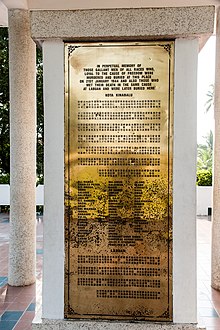| Jesselton revolt | |||||||
|---|---|---|---|---|---|---|---|
| Part of World War II | |||||||
 Some names of resistance movement members aside from the main group who were subsequently executed after the revolt. | |||||||
| |||||||
| Belligerents | |||||||
| Kinabalu Guerrillas Defence Forces |
• Occupied British Borneo | ||||||
| Commanders and leaders | |||||||
|
|
| ||||||
| Units involved | |||||||
|
Limited arms support: |
• Kenpeitai | ||||||
| Strength | |||||||
|
100 Chinese ≈200 Bornean/Philippine indigenous peoples[note 1]/Eurasian/Sikh Indian |
≈Hundreds Japanese police (1943) ≈Thousands Japanese troops (post 1943) | ||||||
| Casualties and losses | |||||||
| 324 resistance members killed | 50–90 police/soldiers killed[note 2] | ||||||
| 2,000–4,000 civilians massacred by the Japanese | |||||||
| History of Malaysia |
|---|
 |
|
|
The Jesselton revolt (also known as the Jesselton uprising or the Double Tenth Revolt/Incident) was a revolt by a resistance movement known as the Kinabalu Guerrillas, comprising local Chinese, indigenous peoples, Eurasian and Sikh Indians of Jesselton, North Borneo and led by Albert Kwok, against the Japanese occupying forces of North Borneo.
The movement succeeded in killing around 50–90 Japanese police and soldiers and temporarily took control of Jesselton (which after the war in 1946 would become the North Borneo and then later Sabah capital) and several neighbouring districts of Tuaran and Kota Belud. Owing to extremely limited arms supplies, however, the movement was forced to retreat to its hide-out. The Japanese Kenpeitai then launched attacks against coastal settlements in western North Borneo to find the leader and members of the guerrilla force, with many innocent civilians suffering the various atrocities that have become synonymous with Japanese conquest in the Pacific War.
The leader of the revolt finally decided to surrender following Japanese threats to execute more civilians if the guerrillas did not turn themselves in. Following the arrest and subsequent execution of the rebel alliance, the Japanese returned to administer North Borneo until 1945 when the main Allied liberation mission arrived.
Cite error: There are <ref group=note> tags on this page, but the references will not show without a {{reflist|group=note}} template (see the help page).